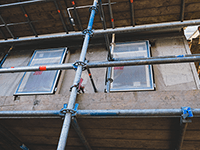
Property flipping has become a popular activity for many landlords and investors. But what is it and how can it be financed?
Our guide explains all you need to know about flipping a property, so you can get started right away...
What is property flipping?
House flipping is when you buy a property that you intend to renovate and sell for a profit.
However, the property doesn't have to be sold. Some people might remortgage it and others may rent it out, to recoup profits.
The general idea is that you will increase the value of the house by renovating it, and in turn, will benefit from making a profit when you come to sell the property.
Some people flip properties on a full-time basis, and it is their primary career. Whereas others may do it as a side hustle to get some extra income.
When is the best time to flip a property?
When house prices are lower you will be able to buy properties at more reasonable prices. However, it does mean that your property may not sell for as much money when you have finished the project.
In comparison, when property prices are higher it will cost you more to buy a house to flip. Once your project concludes, however, the house is likely to sell for a higher price.
Therefore, it is dependent on the funding and resources you have available. So, the best time to flip a property is when you’re ready and able to do it.
Is property flipping worth it?
Flipping a property can be profitable if carried out correctly, so some may argue that it is a worthwhile business venture.
However, it can be a lot of work, time and money. Therefore, it is best to consider your own goals and the resources you have before determining if it is worth going down this path.
How does house flipping work?
Whilst it seems complex, the process can be quite simple if you know what you are doing or if you ask for help from professionals.
First, it’s always worth getting a decision in principle from a lender, to understand how much you can borrow (if you need funding for the project). This is important as it directly impacts the property you can afford to buy.
Next, you need to find a property you want to flip. Many investors look at property auctions to find houses. Normally, these properties can be bought below market value, as they’re often not in a habitable condition. This means you might be able to get a great bargain.
Before you decide it is always a good idea to visit the house, if possible, to make sure you understand what renovations are required and how much these might cost.
Once you’ve purchased the property, the work begins. Now you need to renovate the house and make all the necessary changes, which may increase its value. When you’re satisfied, it’s time to sell, remortgage or rent the property out and repay your loan.
And that’s it.
How do you finance a house flip?
Financing a house flip may seem complicated, but it is more straightforward than you might think.
One option that can be used is a secured loan. This finance option takes a property you own as security against the loan, meaning if you don't keep up with repayments it could be repossessed. Whilst this may be risky, it could help you with funding some of the project, but it depends on how much you can borrow. Repayments on this option are taken each month until the end of the term.
Additionally, an unsecured loan may also be used. However, the loan sizes are a lot smaller on this option, so you may not be able to get the full amount of funding you need. Therefore, this may only be worthwhile if the amount needed is small.
A common way is to take out a bridging loan / ‘buy to sell mortgage’, which is also secured against a property you own. With these loans, you can fund the purchase of the property and the renovations required. Repayment of the loan will occur once you have sold, remortgaged or let the property out.
The amount you can borrow on any of these options will be based on your background and the specific provider. Therefore, it is not guaranteed you will be accepted for the full amount you require.
Getting a decision in principle before you start looking for properties will give you a good steer on what you could afford. It could also be a good idea to speak with an adviser about the different types of loans available to you to find the best option.
How do buy to sell mortgages work?
Buy to sell mortgages are short-term funding solutions commonly known as bridging loans. Typically, they last from 6 months to three years, and they can help you cover the cost of your project for this length of time.
With these options, you will need to repay the full balance (including interest, which is usually higher on these loans) at the end of the term. This differs from lots of other finance options where you make monthly repayments towards the loan.
Essentially, they help you to bridge the gap until you have a longer-term finance solution in place. This could include selling the property, remortgaging it or getting a buy to let mortgage.
An important thing to lock down before you apply for this option is your repayment strategy. Many lenders may be reluctant to offer you a solution without seeing a clear plan, so it is always worth making sure you have it mapped out before applying.
How do I get a buy to sell mortgage?
These options are offered by lenders and banks. All you need to do is speak with one of these providers, or a broker, to get more information. The rest of the process will be managed by them.
Each provider will have different products, eligibility criteria and terms, so you must take the time to research to find the right deal for you.
The type of deal you get depends on the provider you choose to go with and your circumstances.
Summary
To sum up, property flipping can be a profitable path to go down, but its success can depend on your goals and resources. Financing this type of activity can be achieved by taking out a loan, however, the amount you are eligible for will be based on your financial situation and the lender you choose to go with. These solutions can be accessed by reaching out to a lender, bank or broker, so it can be easy to achieve.
Any property used as security, which may include your home, may be repossessed if you do not keep up repayments on your mortgage.




